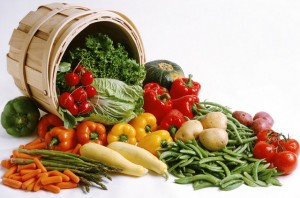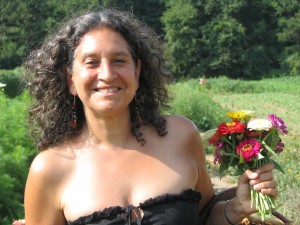List of Ways to Go Gluten-Free
 Gluten-free is a buzz word these days. Many people actually have an intolerance to gluten. Everyone can benefit from less gluten in their diet but for people who have a gluten intolerance — it will change their lives!
Gluten-free is a buzz word these days. Many people actually have an intolerance to gluten. Everyone can benefit from less gluten in their diet but for people who have a gluten intolerance — it will change their lives!
I’m pretty sure my hubby Jay has a gluten intolerance — and he’s finally taking my advice and going to see an allergist about it. If he has it we’ll have to change the way we shop, eat and think! But that’s OK — I’m up for the challenge. The Organic Gourmet, Leslie Cerier, who has guest blogged before and introduced us to 10 gluten-free grains for everyone to incorporate into our diets. Now here’s a checklist if you want to go gluten-free!
by Leslie Cerier, The Organic Gourmet
Everyone can benefit from eating a wide range of gluten-free whole grains. Gluten-free cooking and baking goes beyond just replacing the few popular gluten grains wheat, barley, triticale, and rye in favorite recipes. It is a celebration of the earth’s bounty. There are more whole grains that do not have gluten. More choices, more whole grains and whole grain flours to mix and match with local, seasonal produce for an endless variety of daily meals.
Gluten-Free Makeovers: you can make pasta dishes, pastries, just about everything that can be made with gluten can be made into delicious, nutritious, gorgeous dishes with a wide gluten-free whole grains and flours.
Beyond Toast: Start your day with nutritional powerhouses: gluten-free grains such as millet, rolled oats, teff, quinoa, and amaranth make tasty porridges cooked in water or coconut milk with a variety spices like ginger and cinnamon, and dried fruits. Top with your favorite yogurt, milk, fruit, or maple syrup for a great breakfast.
Pancakes and waffles are delicious and super nutritious made with one or a combination of gluten-free flours: teff, sorghum, quinoa, brown rice, corn, buckwheat, maca, and coconut flour.
Versatile vegetarian and vegan dishes: loaves, polenta, croquettes hold together well. Corn grits, millet and teff: once cooked and cooled can be sliced.
Cook Like An Artist: with earthy toned whole grains. You can make beautiful dishes mixing and matching grains with nuts, seeds, and colorful vegetables. Decorate finished dishes with edible flowers, springs of herbs, and sauces.
Protein:rare for whole grains to be complete proteins: however quinoa, amaranth, buckwheat and oats are complete proteins making them ideal for main course entrees, and side dishes.
Variety of Textures: You can create dishes with many different textures: running the gamut from dense, smooth dishes like polenta to chewy wild rice to crispy granola. In the realm of desserts alone, grains and their flours can be used to create textures ranging from creamy rice pudding to dense, chewy hazelnut brownies to crispy cookies made with teff flour.
Great Pastries Everyone will Love: Bake delicious cookies, piecrusts, fruit crisps, muffins, and brownies with a great variety of gluten-free flours: teff, oat, brown rice, quinoa, coconut, ground nut and seed flours (hazelnut, almond, and flax seeds, etc).
Vegetarian Sushi, also known as nori rice rolls are delicious and easy to prepare with a wide variety of rice: Bhutanese Red Rice, Forbidden Rice, brown rice, Jade Pearl Rice, sweet brown rice, among others. Mix and match with fresh and sautéed seasonal vegetables (cucumbers, carrots, beets, salad greens, etc) with avocado, pickles, sprouts, seasoned tofu and ginger tempeh, and more.
Variety of Shapes: Gluten-free pasta comes in many shapes and sizes and made from a variety of grains: rice, quinoa, corn, amaranth, and buckwheat. All are great topped with savory sauces: tomato, peanut, pesto, mushroom, among others.
Expand your Repertoire: Say yes to abundance of choices: enhance your nutrition by including high fiber, whole grains in your diet. You can make pilafs, soups, stews, porridge, and marinated salads and more with gluten-free grains.
Environmentally friendly, lessen your carbon footprint: some gluten-free grains are drought resistant, requiring less land and less water to produce high yields. Others grow in harsh conditions, arid uplands to moist tropical settings. Huge monocultures of wheat and other common grains have damaging impacts on the earth, especially when grown commercially using petroleum-based fertilizers, herbicides, and pesticides. Because many varieties of gluten-free grains are more closely related to their wild cousins than the hybrids we’ve come to rely on, they can often be grown more easily, using less intensive methods. As a bonus, many of them offer superior nutrition and higher-quality protein than wheat and other common grains. That means more net nutrition from the same amount of land. And best of all, this approach to easing our impact on the planet offers a delicious culinary adventure.
Worldwide, gluten-Free whole grains truly are the foundation of a healthful diet—healthful not just for us humans, but also for our planet. You’ve probably heard about the devastation of rainforests to create grazing land, water pollution from feedlots, and the problems with methane from cattle. And chances are, at some point you’ve read or heard that eating lower on the food chain is more sustainable, so I’ll just offer the reminder that it’s far more efficient to eat grain than to feed it to animals and then use those animals for food. As food resources grow scarce for an ever-increasing human population, it becomes more important to eat less meat, or avoid it altogether. All of that said, I do believe that there’s a place for organic eggs and dairy products, especially when the animals that produce them are allowed to range freely and fed a diet that’s more natural for them (for dairy cows, that means grass-fed).
Adapted and excerpted with permission from Gluten-Free Recipes for the Conscious Cook by Leslie Cerier (New Harbinger Publications)
Leslie Cerier, “The Organic Gourmet” is a national authority on gluten-free cooking and baking specializing in local, seasonal, whole foods and organic cuisine with 20 + years experience: Chef, Educator, Environmentalist, Photographer and Author of 5 cookbooks: Gluten-Free Recipes for the Conscious Cook (2010), Going Wild in the Kitchen (2005), among others. Leslie teaches vegetarian cooking for health, vitality and pleasure nationwide. Leslie’s expertise in culinary nutrition has led to her being much sought after by natural food companies, health professionals and private clients to help them translate challenging dietary allergy issues into culinary success and meal satisfaction.



Leave a Reply
Want to join the discussion?Feel free to contribute!